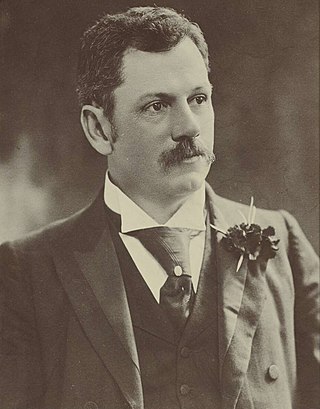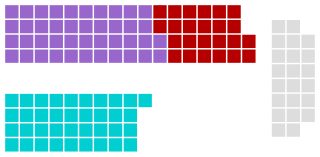Leaders
| # | Leader | Term start | Term end | Time in office | Premier | |
|---|---|---|---|---|---|---|
| 1 |  | John See | 28 March 1901 | 14 June 1904 | 3 years, 78 days | Yes (1901–04) |
| 2 |  | Thomas Waddell | 15 June 1904 | 9 May 1907 | 2 years, 328 days | Yes (1904) |
Progressive Party | |
|---|---|
| Leader | John See Thomas Waddell |
| Founded | 1901 |
| Dissolved | 1907 |
| Preceded by | Protectionist Party (NSW) |
| Headquarters | Sydney |
| Ideology | Protectionism Social liberalism |
| National affiliation | Protectionist Party |
| Legislative Assembly | 42 / 125 (1901−1904) |
The Progressive Party was an Australian political party, active in New South Wales state politics. The question of tariff policy which, had created and divided the Free Trade Party and Protectionist Party in New South Wales in the 1890s, became a federal issue at the time of federation. Deprived of their main ideological difference, the two parties were recreated as the Liberal Reform Party aligned with the federal Free Trade Party and the Progressive Party aligned with the federal Protectionist Party.
There was a rapid decline in the parliamentary representation of the party, from a high of 42 seats at the 1901 election, [1] to 16 at the 1904 election. [2] In April and May 1907, the party had negotiated a coalition agreement with the Liberal Reform Party but this was rejected by a vote of parliamentary members. [3] The party leader Thomas Waddell resigned and joined the Liberal Reform Party, [4] and was followed by John McFarlane, Brinsley Hall, John Gillies and John Perry. Of the remaining ten former Progressive Party members, a further five lost their seats at the 1907 election, [5]
In 1919, the Farmers' and Settlers' Association and the Graziers' Association founded a new Progressive Party, which, while not a direct successor, included members of the former party such as George Briner and Walter Bennett. The new party won metropolitan and rural seats in the 1920 election [6] and was a forerunner to the Country Party.
| # | Leader | Term start | Term end | Time in office | Premier | |
|---|---|---|---|---|---|---|
| 1 |  | John See | 28 March 1901 | 14 June 1904 | 3 years, 78 days | Yes (1901–04) |
| 2 |  | Thomas Waddell | 15 June 1904 | 9 May 1907 | 2 years, 328 days | Yes (1904) |
| Election | Seats won | ± | Total votes | % | Position | Leader |
|---|---|---|---|---|---|---|
| 1901 | 42 / 125 | 44,817 | 22.9% | Minority government | John See | |
| 1904 | 16 / 90 | 75,297 | 18.9% | Third party | Thomas Waddell | |
| 1907 | 5 / 90 | 21,759 | 4.7% | Third party | ||
The Liberal Reform Party was an Australian political party, active in New South Wales state politics between 1901 and 1916. It drew much of its support from Protestant and Temperance groups.

John Lionel Fegan was a politician and coal miner in New South Wales, Australia.

The Waddell ministry was the 31st ministry of the New South Wales Government, and was led by the 15th Premier, Thomas Waddell. The title of Premier was widely used to refer to the Leader of Government, but was not a formal position in the government until 1920. Instead the Premier was appointed to another portfolio, usually Colonial Secretary, however in this case Waddell chose to retain his previous portfolio of Colonial Treasurer.

The Carruthers ministry was the 32nd ministry of the New South Wales Government, and was led by the 16th Premier, Joseph Carruthers. The title of Premier was widely used to refer to the Leader of Government, but was not a formal position in the government until 1920. Instead the Premier was appointed to another portfolio, usually Colonial Secretary. In this case, Carruthers chose the portfolio of Treasurer.
Tamworth, an electoral district of the Legislative Assembly in the Australian state of New South Wales, has had two incarnations from 1890 until 1920 and from 1927 until the present. It initially returned two members until 1894 and has since returned a single member for all subsequent elections.

The Wade ministry was the 33rd ministry of the New South Wales Government, and was led by the 17th Premier, Charles Wade. The title of Premier was widely used to refer to the Leader of Government, but was not a formal position in the government until 1920. Instead the Premier was appointed to another portfolio and Wade chose to keep the portfolio of Attorney General he held in the Carruthers ministry.

The 1901 New South Wales state election was held on 3 July 1901 for all of the 125 seats in the 19th New South Wales Legislative Assembly and it was conducted in single-member constituencies with a first past the post voting system. The Parliamentary Electorates Act of 1893 had conferred the right to vote on every male British subject over 21 years of age who was resident in New South Wales for a year or more. The 19th parliament of New South Wales was dissolved on 11 June 1901 by the Governor, Lord Beauchamp, on the advice of the Premier, John See.
Darling Harbour, an electoral district of the Legislative Assembly in the Australian state of New South Wales was created in 1904 and abolished in 1913.
The 1907 New South Wales state election involved 90 electoral districts returning one member each. The election was conducted on the basis of a simple majority or first-past-the-post voting system.
The 1904 New South Wales state election involved 90 electoral districts returning one member each. The election was conducted on the basis of a simple majority or first-past-the-post voting system. There were two significant changes from the 1901 election, the first was that women were given the right to vote, which saw an increase in the number of enrolled voters from 345,500 in 1901, to 689,490 in 1904. The second was that as a result of the 1903 New South Wales referendum, the number of members of the Legislative Assembly was reduced from 125 to 90. The combined effect of the changes meant that the average number of enrolled voters per electorate went from 2,764, to 7,661, an increase of 277%. Leichhardt was the only district that was not substantially changed, while The Macquarie and The Murray districts retained nothing but the name.
Ashfield, an electoral district of the Legislative Assembly in the Australian state of New South Wales, had three incarnations, the first from 1894 to 1920, the second from 1927 to 1959 and the third from 1968 to 1999.
Belmore, an electoral district of the Legislative Assembly in the Australian state of New South Wales was created in 1904 and abolished in 1920.
Belubula, an electoral district of the Legislative Assembly in the Australian state of New South Wales was created in 1904 and abolished in 1913.
Blayney, an electoral district of the Legislative Assembly in the Australian state of New South Wales was created in 1904 and abolished in 1913.
Cobar, an electoral district of the Legislative Assembly in the Australian state of New South Wales had two incarnations, from 1894 until 1920 and from 1930 until 1968.
The Hastings and The Macleay, an electoral district of the Legislative Assembly in the Australian state of New South Wales was created in 1894 and abolished in 1920.
Paddington, an electoral district of the Legislative Assembly in the Australian state of New South Wales, had two incarnations, from 1859 to 1920 and from 1927 to 1959.
Queanbeyan, an electoral district of the Legislative Assembly in the Australian state of New South Wales was created in 1859 and abolished in 1913.
The Richmond, an electoral district of the Legislative Assembly in the Australian state of New South Wales, was created in 1880 and abolished in 1913.